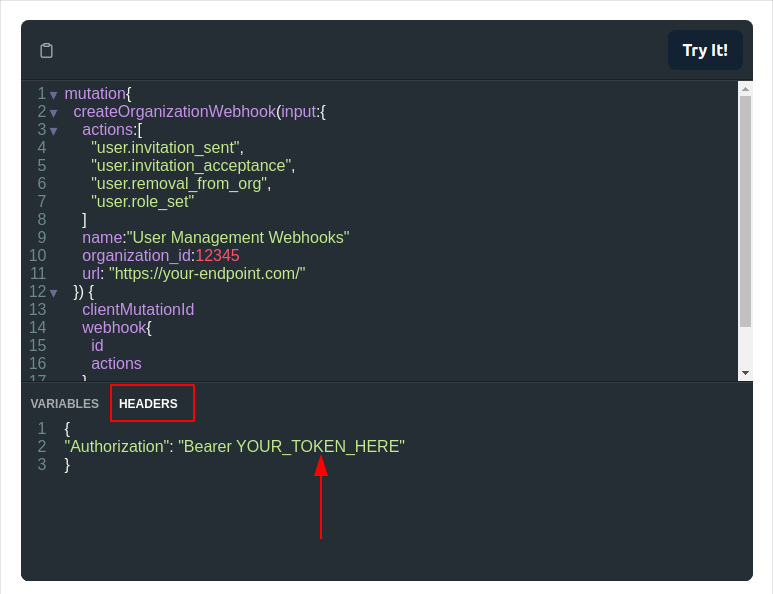Definition
Organization webhooks are payloads that are sent to a configured endpoint whenever an action occurs at the organization level. Currently, this includes user management webhooks, such as: user.invitation_sent, user.invitation_acceptance, user.role_set, user.removal_from_org
Queries
Queries are used to fetch data using the parameters you've given as arguments. If you want to know more about queries and other GraphQL terms, read here
Below is how you query for a certain organization's webhooks. This takes in the organization's ID as it's only argument:
{
organization(id: 12345) {
webhooks {
id
name
email
actions
url
headers
}
}
}
{
organizations(ids: [12345, 67890, 98765]) {
webhooks {
id
name
email
actions
url
headers
}
}
}
Mutations
If you want to create, make a change to, or eliminate a webhook, you can do that using a mutation.
Create
The first tab in the code block shows how to create an organization webhook. The required arguments are:
actions: [String]!(seeUser Management Webhookssection to see which valid actions are available)name: String!url: String!organization_id: ID!
Update
The second tab in the code block shows how to update an organization webhook. In the example, we're updating the action, headers, and email parameters of a webhook. The webhook's ID is the only necessary argument.
Delete
The third tab in the code block shows how to delete an organization webhook. The webhook's ID is the only necessary argument.
mutation {
createOrganizationWebhook(input: {
actions: ["user.invitation_sent"],
name: "Webhook 1",
organization_id: 123456,
url: "https://your-endpoint.com/"
}) {
webhook {
id
actions
url
}
}
}
mutation{
updateOrganizationWebhook(input:{
id:123
actions:["user.role_set"] # New action
headers:["Header"] # New header
email:"[email protected]" # Adding Email
})
}
mutation {
deleteOrganizationWebhook(input: {id: 123})
}
User Management Webhooks
User Invited
Suppose you want to receive a webhook payload with the event's information whenever a user is invited to your organization. In this case, you can use user.invitation_sent as an argument in the actions parameter. See below how to create this webhook:
mutation {
createOrganizationWebhook(input: {
actions: ["user.invitation_sent"],
name: "User Invited",
organization_id: 123456,
url: "https://your-endpoint.com/"}) {
webhook {
id
actions
url
}
}
}
Response for invitation_sent
invitation_sentBelow is an example of this webhook's payload format.
{
"data": {
"payload_id": "0x0x0x0x-0xx0-00xx-0000-x0x000x0x000",
"action": "user.invitation_sent",
"user": {
"id": 12345,
"name": "John Doe",
"username": "john-doe",
"email": "[email protected]",
"avatar_url": "https://gravatar.com/avatar/0000x0x0x000000x0x00000xx0000xx0.png?s=144\u0026d=https://pipestyle.staticpipefy.com/v2-temp/illustrations/avatar.png"
},
"user_invited_by": {
"id": 98765,
"name": "Jane Doe",
"username": "jane-doe",
"email": "[email protected]"
},
"to": { "organization_id": 11111, "name": "Organization 1" }
}
}
Invitation Accepted
Suppose you want to receive a webhook payload with the event's information whenever someone you've invited to join your company accepts the invitation. You can use user.invitation_acceptance as an argument in the actions parameter of the webhook creation mutation.
Important
The webhook only triggers if a user with that email address has not yet been created within Pipefy, and only if they create an account via the invitation link. If a person creates an account manually, and is then invited to an organization, this webhook will not be triggered.
Below is an example of how to create this webhook:
mutation {
createOrganizationWebhook(input: {
actions: ["user.invitation_acceptance"],
name: "User Invitation Acceptance",
organization_id: 123456,
url: "https://your-endpoint.com/"}) {
webhook {
id
actions
url
}
}
}
Response for invitation_acceptance
invitation_acceptanceBelow is an example of this webhook's payload format.
{
"data": {
"payload_id": "0x0x0x0x-0xx0-00xx-0000-x0x000x0x000",
"action": "user.invitation_acceptance",
"user": {
"id": 12345,
"name": "John Doe",
"username": "john-doe",
"email": "[email protected]",
"avatar_url": "https://gravatar.com/avatar/0000x0x0x000000x0x00000xx0000xx0.png?s=144\u0026d=https://pipestyle.staticpipefy.com/v2-temp/illustrations/avatar.png"
},
"accepted_at": "2022-03-22 23:21:57 UTC"
}
}
Permission Role Change
Suppose you want to receive a webhook payload with the event's information whenever a user has their permission changed at an organization level. You can use user.role_set as an argument in the actions parameter of the webhook creation mutation. Below is an example of how to create this webhook:
mutation {
createOrganizationWebhook(input: {
actions: ["user.role_set"],
name: "User Permission Change (Organization)",
organization_id: 123456,
url: "https://your-endpoint.com/"}) {
webhook {
id
actions
url
}
}
}
Response for role_set
role_setBelow is an example of this webhook's payload format.
{
"data": {
"payload_id": "0x0x0x0x-0xx0-00xx-0000-x0x000x0x000",
"action": "user.role_set",
"user": {
"id": 12345,
"name": "John Doe",
"username": "john-doe",
"email": "[email protected]",
"avatar_url": "https://gravatar.com/avatar/0000x0x0x000000x0x00000xx0000xx0.png?s=144\u0026d=https://pipestyle.staticpipefy.com/v2-temp/illustrations/avatar.png"
},
"action_done_by": {
"id": 98765,
"name": "Jane Doe",
"username": "jane-doe",
"email": "[email protected]"
},
"from": { "organization_id": 11111, "name": "Organization 1" },
"previous_role": null,
"new_role": "admin",
"action_done_at": "2022-03-22 20:06:14 -0300"
}
}
Removal From Organization
Suppose you want to receive a webhook payload with the event's information whenever a user is removed from your organization. You can use user.removal_from_org as an argument in the actions parameter of the webhook creation mutation. Below is an example of how to create this webhook:
mutation {
createOrganizationWebhook(input: {
actions: ["user.removal_from_org"],
name: "User Removal From Organization",
organization_id: 123456,
url: "https://your-endpoint.com/"}) {
webhook {
id
actions
url
}
}
}
Response for removal_from_org
removal_from_orgBelow is an example of this webhook's payload format.
{
"data": {
"payload_id": "0x0x0x0x-0xx0-00xx-0000-x0x000x0x000",
"action": "user.removal_from_org",
"user": {
"id": 12345,
"name": "John Doe",
"username": "john-doe",
"email": "[email protected]",
"avatar_url": "https://gravatar.com/avatar/0000x0x0x000000x0x00000xx0000xx0.png?s=144\u0026d=https://pipestyle.staticpipefy.com/v2-temp/illustrations/avatar.png"
},
"user_removed_by": {
"id": 98765,
"name": "Jane Doe",
"username": "jane-doe",
"email": "[email protected]"
},
"from": { "organization_id": 11111, "name": "Organization 1" },
"action_done_at": "2022-03-22 20:45:36 -0300"
}
}
Testing Our API
For a full list of our GraphQL capabilities, you can access our GraphQL playground and play around with it.
API Authentication
Our API is protected, so you have to provide your access token to be able to complete the requests to our API.
You can read more about our Authentication and how to get your access token in our Authentication section.Once you have the token in hands, within our playground you'll have to add a key in the headers named "Authorization", and the value must be the name "Bearer" followed by your token, like in the image below.

